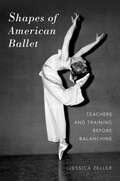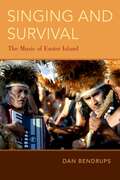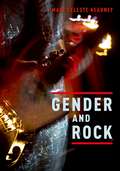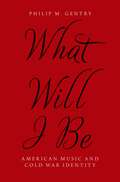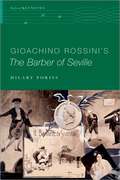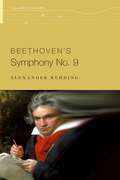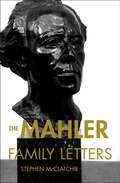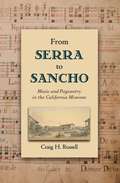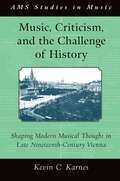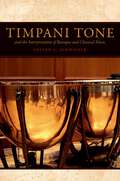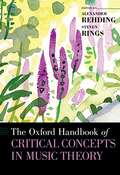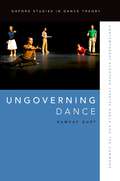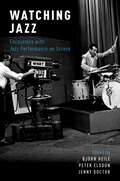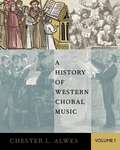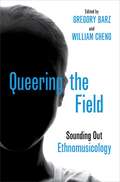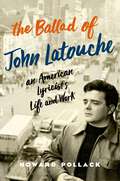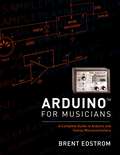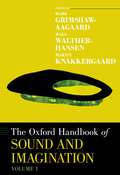- Table View
- List View
Shapes of American Ballet: Teachers and Training before Balanchine
by Jessica ZellerIn Shapes of American Ballet: Teachers and Training before Balanchine, Jessica Zeller introduces the first few decades of the twentieth century as an often overlooked, yet critical period for ballet's growth in America. While George Balanchine is often considered the sole creator of American ballet, numerous European and Russian émigrés had been working for decades to build a national ballet with an American identity. These pedagogues and others like them played critical yet largely unacknowledged roles in American ballet's development. Despite their prestigious ballet pedigrees, the dance field's exhaustive focus on Balanchine has led to the neglect of their work during the first few decades of the century, and in this light, this book offers a new perspective on American ballet during the period immediately prior to Balanchine's arrival. Zeller uses hundreds of rare archival documents to illuminate the pedagogies of several significant European and Russian teachers who worked in New York City. Bringing these contributions into the broader history of American ballet recasts American ballet's identity as diverse-comprised of numerous Euro-Russian and American elements, as opposed to the work of one individual. This new account of early twentieth century American ballet is situated against a bustling New York City backdrop, where mass immigration through Ellis Island brought the ballet from European and Russian opera houses into contact with a variety of American forms and sensibilities. Ballet from celebrated Euro-Russian lineages was performed in vaudeville and blended with American popular dance styles, and it developed new characteristics as it responded to the American economy. Shapes of American Ballet delves into ballet's struggle to define itself during this rich early twentieth century period, and it sheds new light on ballet's development of an American identity before Balanchine.
SHAPES OF AMERICAN BALLET C: Teachers and Training before Balanchine
by Jessica ZellerIn Shapes of American Ballet: Teachers and Training before Balanchine, Jessica Zeller introduces the first few decades of the twentieth century as an often overlooked, yet critical period for ballet's growth in America. While George Balanchine is often considered the sole creator of American ballet, numerous European and Russian émigrés had been working for decades to build a national ballet with an American identity. These pedagogues and others like them played critical yet largely unacknowledged roles in American ballet's development. Despite their prestigious ballet pedigrees, the dance field's exhaustive focus on Balanchine has led to the neglect of their work during the first few decades of the century, and in this light, this book offers a new perspective on American ballet during the period immediately prior to Balanchine's arrival. Zeller uses hundreds of rare archival documents to illuminate the pedagogies of several significant European and Russian teachers who worked in New York City. Bringing these contributions into the broader history of American ballet recasts American ballet's identity as diverse-comprised of numerous Euro-Russian and American elements, as opposed to the work of one individual. This new account of early twentieth century American ballet is situated against a bustling New York City backdrop, where mass immigration through Ellis Island brought the ballet from European and Russian opera houses into contact with a variety of American forms and sensibilities. Ballet from celebrated Euro-Russian lineages was performed in vaudeville and blended with American popular dance styles, and it developed new characteristics as it responded to the American economy. Shapes of American Ballet delves into ballet's struggle to define itself during this rich early twentieth century period, and it sheds new light on ballet's development of an American identity before Balanchine.
Singing and Survival: The Music of Easter Island
by Dan BendrupsAn exemplary investigation into music and sustainability, Singing and Survival tells the story of how music helped the Rapanui people of Easter Island to preserve their unique cultural heritage. Easter Island (or Rapanui), known for the iconic headstones (moai) that dot the island landscape, has a remarkable and enduring presence in global popular culture where it has been portrayed as a place of mystery and fascination, and as a case study in societal collapse. These portrayals often overlook the remarkable survival of the Rapanui people who rebounded from a critically diminished population of just 110 people in the late nineteenth century to what is now a vibrant community where indigenous language and cultural practices have been preserved for future generations. This cultural revival has drawn on a diversity of historical and contemporary influences: indigenous heritage, colonial and missionary influences from South America, and cultural imports from other Polynesian islands, as well as from tourism and global popular culture. The impact of these influences can be perceived in the island's contemporary music culture. This book provides a comprehensive overview of Easter Island music, with individual chapters devoted to the various streams of cultural influence from which the Rapanui people have drawn to rebuild and reinforce their music, their performances, their language and their presence in the world. In doing so, it provides a counterpoint to deficit discourses of collapse, destruction and disappearance to which the Rapanui people have historically been subjected.
Gender and Rock
by Mary Celeste KearneyThe first book of its kind, Gender & Rock introduces readers to how gender operates in multiple sites within rock culture, including its music, lyrics, imagery, performances, instruments, and business practices. Additionally, it explores how rock culture, despite a history of regressive gender politics, has provided a place for musicians and consumers to experiment with alternate identities and ways of being. Drawing on feminist and queer scholarship in popular music studies, musicology, cultural studies, sociology, performance studies, literary analysis, and media studies, Gender & Rock provides readers with a survey of the topics, theories, and methods necessary for understanding and conducting analyses of gender in rock culture. Via an intersectional approach, the book examines how the gendering of particular roles, practices, technologies, and institutions within rock culture is related to discourses of race, sexuality, age, and class.
GENDER & ROCK C
by Mary Celeste KearneyThe first book of its kind, Gender & Rock introduces readers to how gender operates in multiple sites within rock culture, including its music, lyrics, imagery, performances, instruments, and business practices. Additionally, it explores how rock culture, despite a history of regressive gender politics, has provided a place for musicians and consumers to experiment with alternate identities and ways of being. Drawing on feminist and queer scholarship in popular music studies, musicology, cultural studies, sociology, performance studies, literary analysis, and media studies, Gender & Rock provides readers with a survey of the topics, theories, and methods necessary for understanding and conducting analyses of gender in rock culture. Via an intersectional approach, the book examines how the gendering of particular roles, practices, technologies, and institutions within rock culture is related to discourses of race, sexuality, age, and class.
What Will I Be: American Music and Cold War Identity
by Philip M. GentryIn the wake of World War II, the cultural life of the United States underwent a massive transformation. At the heart of these changes during the early Cold War were the rise of the concept of identity and a reformulation of the country's political life. A revolution in music was taking place at the same time-a tumult of new musical styles and institutions that would lead to everything from the birth of rock 'n' roll to the new downtown experimental music scene. Together, these new cultural and musical trends came to define the era. In the search for new social affinities and modes of self-fashioning, music provided just the right tool. What Shall I Be follows the concept of identity as it developed alongside new post-war music making. Author Philip M. Gentry travels through four very different musical scenes: the R&B world of doo-wop pioneers the Orioles, the early film musicals of Doris Day, Asian American cabaret in San Francisco, and John Cage's infamous 4'33". The lives of musicians, composers, critics, and fans reveal how individuals negotiated the social changes sweeping the country in the initial days of the Cold War. As we are again swept up in a time of significant transformation, these early strategies help to inform the political and musical narratives of today.
What Will I Be: American Music and Cold War Identity
by Philip M. GentryIn the wake of World War II, the cultural life of the United States underwent a massive transformation. At the heart of these changes during the early Cold War were the rise of the concept of identity and a reformulation of the country's political life. A revolution in music was taking place at the same time-a tumult of new musical styles and institutions that would lead to everything from the birth of rock 'n' roll to the new downtown experimental music scene. Together, these new cultural and musical trends came to define the era. In the search for new social affinities and modes of self-fashioning, music provided just the right tool. What Shall I Be follows the concept of identity as it developed alongside new post-war music making. Author Philip M. Gentry travels through four very different musical scenes: the R&B world of doo-wop pioneers the Orioles, the early film musicals of Doris Day, Asian American cabaret in San Francisco, and John Cage's infamous 4'33". The lives of musicians, composers, critics, and fans reveal how individuals negotiated the social changes sweeping the country in the initial days of the Cold War. As we are again swept up in a time of significant transformation, these early strategies help to inform the political and musical narratives of today.
Gioachino Rossini's The Barber of Seville (Oxford Keynotes)
by Hilary PorissGioachino Rossini's The Barber of Seville surveys the opera's fascinating performance history, mapping out the myriad changes that have affected the work since its premiere, exploring many of the personalities responsible for those alterations, and taking into account the range of reactions that these changes have prompted in spectators and critics from the nineteenth century to the present. Opening with a wide-ranging overview of the types of alterations that have been imposed on Rossini's score for the past two centuries, the first chapter addresses the mechanics behind these changes as well as the cultural forces that both fostered and encouraged them. The book next looks at some of the opera's earliest revivals, drawing attention to alterations that were made to the score and to individual singers who were responsible for the changes, especially those who appeared in the roles of Almaviva and Bartolo. An entire chapter is devoted to Rosina, examining the wide array of creative liberties that prima donnas have unremittingly and unrepentantly taken with their interpretations of Rossini's character. The final sections turn to the opera's recent history, observing how the Rossini Renaissance brought with it a new dedication to the "work concept" and to shedding the types of alterations that had long characterized performances of this work. The book closes with a consideration of operatic consumerism from the nineteenth century to the present, exploring the myriad ways that one can now experience The Barber of Seville in all its recorded, digitized, and commodified glory.
Gioachino Rossini's The Barber of Seville (Oxford Keynotes)
by Hilary PorissGioachino Rossini's The Barber of Seville surveys the opera's fascinating performance history, mapping out the myriad changes that have affected the work since its premiere, exploring many of the personalities responsible for those alterations, and taking into account the range of reactions that these changes have prompted in spectators and critics from the nineteenth century to the present. Opening with a wide-ranging overview of the types of alterations that have been imposed on Rossini's score for the past two centuries, the first chapter addresses the mechanics behind these changes as well as the cultural forces that both fostered and encouraged them. The book next looks at some of the opera's earliest revivals, drawing attention to alterations that were made to the score and to individual singers who were responsible for the changes, especially those who appeared in the roles of Almaviva and Bartolo. An entire chapter is devoted to Rosina, examining the wide array of creative liberties that prima donnas have unremittingly and unrepentantly taken with their interpretations of Rossini's character. The final sections turn to the opera's recent history, observing how the Rossini Renaissance brought with it a new dedication to the "work concept" and to shedding the types of alterations that had long characterized performances of this work. The book closes with a consideration of operatic consumerism from the nineteenth century to the present, exploring the myriad ways that one can now experience The Barber of Seville in all its recorded, digitized, and commodified glory.
Beethoven's Symphony No. 9 (Oxford Keynotes)
by Alexander RehdingBeethoven's Ninth Symphony has held musical audiences captive for close to two centuries. Few other musical works hold such a prominent place in the collective imagination; each generation rediscovers the work for itself and makes it its own. Honing in on the significance of the symphony in contemporary culture, this book establishes a dialog between Beethoven's world and ours, marked by the earthshattering events of 1789 and of 1989. In particular, this book outlines what is special about the Ninth in millennial culture. In the present day, music is encoded not only as score but also as digital technology. We encounter Beethoven 9 flashmobs, digitally reconstructed concert halls, globally synchonized performances, and other time-bending procedures. The digital artwork 9 Beet Stretch even presents the Ninth at glacial speed over twenty-four hours, challenges our understanding of the symphony, and encourages us to confront the temporal dimension of Beethoven's music. In the digital age, the Ninth emerges as a musical work that is recomposed and reshaped-and that is robust enough to live up to such treatment-continually adapting to a changing world with changing media.
BEETHOVEN'S SYMPHONY NO. 9 OKS C (Oxford Keynotes)
by Alexander RehdingBeethoven's Ninth Symphony has held musical audiences captive for close to two centuries. Few other musical works hold such a prominent place in the collective imagination; each generation rediscovers the work for itself and makes it its own. Honing in on the significance of the symphony in contemporary culture, this book establishes a dialog between Beethoven's world and ours, marked by the earthshattering events of 1789 and of 1989. In particular, this book outlines what is special about the Ninth in millennial culture. In the present day, music is encoded not only as score but also as digital technology. We encounter Beethoven 9 flashmobs, digitally reconstructed concert halls, globally synchonized performances, and other time-bending procedures. The digital artwork 9 Beet Stretch even presents the Ninth at glacial speed over twenty-four hours, challenges our understanding of the symphony, and encourages us to confront the temporal dimension of Beethoven's music. In the digital age, the Ninth emerges as a musical work that is recomposed and reshaped-and that is robust enough to live up to such treatment-continually adapting to a changing world with changing media.
The Mahler Family Letters
by Stephen McClatchieHundreds of the letters that Gustav Mahler addressed to his parents and siblings survive, yet they have remained virtually unknown. Now, for the first time Mahler scholar Stephen McClatchie presents over 500 of these letters in a clear, lively translation in The Mahler Family Letters . Drawn primarily from the Mahler-Rose Collection at the University of Western Ontario, the volume presents a complete, well-rounded view of the family's correspondence. Spanning the mid 1880s through 1910, the letters record the excitement of a young man with a bourgeoning career as a conductor and provide a glimpse into his day-to-day activities rehearsing and conducting operas and concerts in Budapeast and Hamburg, and composing his first symphonies and songs. On the private side, they document his parents' illnesses and deaths and the struggles of his siblings Alois, Justine, Otto, and Emma. The letters also give Mahler's insightful impressions of contemporaries such as Johannes Brahms, Richard Strauss, and Hans von Bulow, as well as his personal feelings about significant events, such as his first big success--the completion of Carl Maria von Weber's Die drei Pintos in 1889. In the fall of 1894, the character of the letters changes when Justine and Emma come to live with Mahler in Hamburg and then Vienna, removing the need to communicate by letter about quotidian matters. At this point, the letters relay noteworthy events such as Mahler's campaign to be named Director of the Vienna Court Opera, his conducting tours throughout Europe, and his courtship of Alma Schindler. The Mahler Family Letters provides a vital, nuanced source of information about Mahler's life, his personality, and his relationships. McClatchie has generously annotated each letter, contextualizing and clarifying contemporary historical references and Mahler family acquaintances, and created an indispensable resource for all Mahlerists, 19th-century musicologists, and historians of 19th-century Germany and Austria.
From Serra to Sancho: Music and Pageantry in the California Missions (Currents in Latin American and Iberian Music)
by Craig H. RussellMusic in the California missions was a pluralistic combination of voices and instruments, of liturgy and spectacle, of styles and functions--and even of cultures--in a new blend that was non-existent before the Franciscan friars made their way to California beginning in 1769. From Serra to Sancho explores the exquisite sacred music that flourished on the West Coast of the United States when it was under Spanish and Mexican rule, delving into the historical, cultural, biographical, and stylistic aspects of California mission music during the late eighteenth and early nineteenth centuries. Author Craig H. Russell examines how mellifluous plainchant, reverent hymns, spunky folkloric ditties, "classical" music in the style of Haydn, and even Native American drumming were interwoven into a tapestry of resonant beauty. In addition to extensive musical and cultural analysis, Russell draws upon hundreds of primary documents in California, Mexico, Madrid, Barcelona, London, and Mallorca. It is through the melding together of this information from geographically separated places that he brings the mystery of California's mission music into sharper focus. Russell's groundbreaking study sheds new light on the cultural exchange that took place in the colonial United States, as well as on the pervasive worldwide influence of Iberian music as a whole.
Music, Criticism, and the Challenge of History: Shaping Modern Musical Thought in Late Nineteenth Century Vienna (AMS Studies in Music)
by Kevin KarnesMore than a century after Guido Adler's appointment to the first chair in musicology at the University of Vienna, Music, Criticism, and the Challenge of History provides a first look at the discipline in this earliest period, and at the ideological dilemmas and methodological anxieties that characterized it upon its institutionalization. Author Kevin Karnes contends that some of the most vital questions surrounding musicology's disciplinary identities today-the relationship between musicology and criticism, the role of the subject in analysis and the narration of history, and the responsibilities of the scholar to the listening public-originate in these conflicted and largely forgotten beginnings. Karnes lays bare the nature of music study in the late nineteenth century through insightful readings of long-overlooked contributions by three of musicology's foremost pioneers-Adler, Eduard Hanslick, and Heinrich Schenker. Shaped as much by the skeptical pronouncements of the likes of Nietzsche and Wagner as it was by progressivist ideologies of scientific positivism, the new discipline comprised an array of oft-contested and intensely personal visions of music study, its value, and its future. Karnes introduces readers to a Hanslick who rejected the call of positivist scholarship and dedicated himself to penning an avowedly subjective history of Viennese musical life. He argues that Schenker's analytical experiments had roots in a Wagner-inspired search for a critical alternative to Adler's style-obsessed scholarship. And he illuminates Adler's determined response to Nietzsche's warnings about the vitality of artistic and cultural life in an increasingly scientific age. Through sophisticated and meticulous presentation, Music, Criticism, and the Challenge of History demonstrates that the new discipline of musicology was inextricably tied in with the cultural discourse of its time.
Timpani Tone and the Interpretation of Baroque and Classical Music
by Steven L. SchweizerTimpani Tone and the Interpretation of Baroque and Classical Music explores the nature, production, and evolution of timpani tone and provides insights into how to interpret the music of J. S. Bach, Handel, Haydn, and Mozart. In drawing on 31 years of experience, Steven L. Schweizer focuses on the components of timpani tone and methods for producing it. In so doing, he discusses the importance of timpani bowl type; mallets; playing style; physical gestures; choice of drums; mallet grip; legato, marcato, and staccato strokes; playing different parts of the timpano head; and psychological openness to the music in effectively shaping and coloring timpani parts. In an acclaimed chapter on interpretation, Schweizer explores how timpanists can use knowledge of the composer's style, psychology, and musical intentions; phrasing and articulation; the musical score; and a conductor's gestures to effectively and convincingly play a part with emotional dynamism and power. The greater part of the book is devoted to the interpretation of Baroque and Classical orchestral and choral music. Meticulously drawing on original sources and authoritative scores from the seventeenth through nineteenth centuries, Schweizer convincingly demonstrates that timpanists were capable of producing a broader range of timpani tone earlier than is normally supposed. The increase in timpani size, covered timpani mallets, and thinner timpani heads increased the quality of timpani tone; therefore, today's timpanist's need not be entirely concerned with playing with very articulate sticks. In exhaustive sections on Bach, Handel, Haydn, and Mozart, Schweizer takes the reader on an odyssey through the interpretation of their symphonic and choral music. Relying on Baroque and Classical performance practices, timpani notation, the composer's musical style, and definitive scores, he interprets timpani parts from major works of these composers. Schweizer pays particular attention to timpani tone, articulation, phrasing, and dynamic contouring: elements necessary to effectively communicate their part to listeners.
The Oxford Handbook of Critical Concepts in Music Theory (Oxford Handbooks)
Music Theory has a lot of ground to cover. Especially in introductory classes a whole range of fundamental concepts are introduced at fast pace that can never be explored in depth or detail, as other new topics become more pressing. The short time we spend with them in the classroom belies the complexity (and, in many cases, the contradictions) underlying these concepts. This book takes the time to tarry over these complexities, probe the philosophical assumptions on which these concepts rest, and shine a light on all their iridescent facets. This book presents music-theoretical concepts as a register of key terms progressing outwards from smallest detail to discussions of the music-theoretical project on the largest scale. The approaches individual authors take range from philosophical, historical, or analytical to systematic, cognitive, and critical-theorical-covering the whole diverse spectrum of contemporary music theory. In some cases authors explore concepts that have not yet been widely added to the theorist's toolkit but deserve to be included; in other cases concepts are expanded beyond their core repertory of application. This collection does not shy away from controversy. Taken in their entirety, the essays underline that music theory is on the move, exploring new questions, new repertories, and new approaches. This collection is an invitation to take stock of music theory in the early twenty-first century, to look back and to encourage discussion about its future directions. Its chapters open up a panoramic view of the contemporary music-theoretical landscape with its expanding repertories and changing guiding questions, and offers suggestions as to where music theory is headed in years to come.
UNGOVERNING DANCE OSDT C: Contemporary European Theatre Dance and the Commons (Oxford Studies in Dance Theory)
by Ramsay BurtUngoverning Dance examines the work of progressive contemporary dance artists in continental Europe from the mid 1990s to 2015. Placing this within the context of neoliberalism and austerity, the book argues that these artists have developed an ethico-aesthetic approach that uses dance practices as sites of resistance against dominant ideologies, and that their works attest to the persistence of alternative ways of thinking and living. In response to the way that the radical values informing their work are continually under attack from neoliberalism, these artists recognise that they in effect share common pool resources. Thus, while contemporary dance has been turned into a market, they nevertheless value the extent to which it functions as a commons. Work that does this, it argues, ungoverns dance. The book offers close readings of works from the 1990s and 2000s by two generations of European-based dance artists: that of Jérôme Bel, Jonathan Burrows, La Ribot, and Xavier Le Roy who began showing work in the 1990s; and that of artists who emerged in the 2000s including Fabián Barba, Faustin Linyekula, Ivana Müller, and Nikolina Pristas. Topics examined include dance and precarious life, choreographing friendship, re-performance, the virtual in dance, and a dancer's experience of the Egyptian revolution. Ungoverning Dance proposes new ways of understanding recent contemporary European dance works by making connections with their social, political, and theoretical contexts.
WATCHING JAZZ C: Encounters with Jazz Performance on Screen
by Björn Heile, Peter Elsdon, and Jenny DoctorWatching Jazz: Encounters with Jazz Performance on Screen is the first systematic study of jazz on screen media. Where earlier studies have focused almost entirely on the role and portrayal of jazz in Hollywood film, the present book engages with a plethora of technologies and media from early film and soundies through television to recent developments in digital technologies and online media. Likewise, the authors discuss jazz in the widest sense, ranging from Duke Ellington and Jimmy Dorsey through the likes of Dizzy Gillespie, Art Blakey, Oscar Peterson, Miles Davis, John Coltrane and Charles Mingus to Pat Metheny. Much of this rich and fascinating material has never been studied in depth before, and what emerges most clearly are the manifold connections between the music and the media on which it was and is being recorded. Its long association with film and television has left its trace in jazz, just as online and social media are subtly shaping it now. Vice versa, visual media have always benefited from focusing on music and this significantly affected their development. The book follows these interrelations, showing how jazz was presented and represented on screen and what this tells us about the music, the people who made it and their audiences. The result is a new approach to jazz and the media, which will be required reading for students of both fields.
HIST OF WESTERN CHORAL MUSIC, VOL 1 C
by Chester L. AlwesA History of Western Choral Music explores the various genres, key composers, and influential works essential to the development of the western choral tradition. Author Chester L. Alwes divides this exploration into two volumes which move from Medieval music and the Renaissance era up to the 21st century. Volume I surveys the choral music of composers including Josquin, Palestrina, Purcell, Handel, and J.S. Bach while detailing the stylistic, textual, and extramusical considerations unique to the topics covered. Consideration of Renaissance music includes both sacred and secular works, specifically addressing the growth of sacred music, the rise of secular music, and the proliferation of sacred polyphony from Josquin to Palestrina. Discussion of the Baroque era is organized by geographic location, exploring the spread of Baroque style from Italy to German, France, and England. Volume I concludes by examining the aesthetic underpinnings of the early Classical and Romantic eras. Framing discussion within the political, religious, cultural, philosophical, aesthetic, and technological contexts of each era, A History of Western Choral Music offers readers specialized insight into major composers and works while providing a cohesive understanding of choral music's place in Western history.
Queering the Field: Sounding Out Ethnomusicology
Drawing on ethnographic research and often deeply personal experiences with musical cultures, Queering the Field: Sounding out Ethnomusicology unpacks a history of sentiment that veils the treatment of queer music and identity within the field of ethnomusicology. The thematic structure of the volume reflects a deliberate cartography of queer spaces in the discipline-spaces that are strongly present due to their absence, are marked by direct sonic parameters, or are called into question by virtue of their otherness. As the first large-scale study of ethnomusicology's queer silences and queer identity politics, Queering the Field directly addresses the normativities currently at play in musical ethnography (fieldwork, analysis, performance, transcription) as well as in the practice of musical ethnographers (identification, participation, disclosure, observation, authority). While rooted in strong narrative convictions, the authors frequently adopt radicalized voices with the goal of queering a hierarchical sexual binary. The essays in the volume present rhetorical and syntactical scenarios that challenge us to read in prescient singular ways for future queer writing and queer thought in ethnomusicology.
QUEERING THE FIELD C: Sounding Out Ethnomusicology
by Gregory Barz and William ChengDrawing on ethnographic research and often deeply personal experiences with musical cultures, Queering the Field: Sounding out Ethnomusicology unpacks a history of sentiment that veils the treatment of queer music and identity within the field of ethnomusicology. The thematic structure of the volume reflects a deliberate cartography of queer spaces in the discipline-spaces that are strongly present due to their absence, are marked by direct sonic parameters, or are called into question by virtue of their otherness. As the first large-scale study of ethnomusicology's queer silences and queer identity politics, Queering the Field directly addresses the normativities currently at play in musical ethnography (fieldwork, analysis, performance, transcription) as well as in the practice of musical ethnographers (identification, participation, disclosure, observation, authority). While rooted in strong narrative convictions, the authors frequently adopt radicalized voices with the goal of queering a hierarchical sexual binary. The essays in the volume present rhetorical and syntactical scenarios that challenge us to read in prescient singular ways for future queer writing and queer thought in ethnomusicology.
The Ballad of John Latouche: An American Lyricist's Life and Work
by Howard PollackBorn into a poor Virginian family, John Treville Latouche (1914-56), in his short life, made a profound mark on America's musical theater as a lyricist, book writer, and librettist. The wit and skill of his lyrics elicited comparisons with the likes of Ira Gershwin, Lorenz Hart, and Cole Porter, but he had too, noted Stephen Sondheim, "a large vision of what musical theater could be," and he proved especially venturesome in helping to develop a lyric theater that innovatively combined music, word, dance, and costume and set design. Many of his pieces, even if not commonly known today, remain high points in the history of American musical theater. "A great American genius" in the words of Duke Ellington, Latouche initially came to wide public attention in his early twenties with his cantata for soloist and chorus, Ballad for Americans (1939), with music by Earl Robinson-a work that swept the nation during the Second World War. Other milestones in his career included the all-black musical fable, Cabin in the Sky (1940), with Vernon Duke; an interracial updating of John Gay's classic, The Beggar's Opera, as Beggar's Holiday (1946), with Duke Ellington; two acclaimed Broadway operas with Jerome Moross: Ballet Ballads (1948) and The Golden Apple (1954); one of the most enduring operas in the American canon, The Ballad of Baby Doe (1956), with Douglas Moore; and the operetta Candide (1956), with Leonard Bernstein and Lillian Hellman. Extremely versatile, he also wrote cabaret songs, participated in documentary and avant-garde film, translated poetry, adapted plays, and much else. Meanwhile, as one of Manhattan's most celebrated raconteurs and hosts, he developed a wide range of friends in the arts, including, to name only a few, Paul and Jane Bowles (whom he introduced to each other), Yul Brynner, John Cage, Jack Kerouac, Frederick Kiesler, Carson McCullers, Frank O'Hara, Dawn Powell, Ned Rorem, Virgil Thomson, Gore Vidal, and Tennessee Williams-a dazzling constellation of diverse artists working in sundry fields, all attracted to Latouche's brilliance and joie de vivre, not to mention his support for their work. This book draws widely on archival collections both at home and abroad, including Latouche's diaries and the papers of Bernstein, Ellington, Moore, Moross, and many others, to tell for the first time, the story of this fascinating man and his work.
The Ballad of John Latouche: An American Lyricist's Life and Work
by Howard PollackBorn into a poor Virginian family, John Treville Latouche (1914-56), in his short life, made a profound mark on America's musical theater as a lyricist, book writer, and librettist. The wit and skill of his lyrics elicited comparisons with the likes of Ira Gershwin, Lorenz Hart, and Cole Porter, but he had too, noted Stephen Sondheim, "a large vision of what musical theater could be," and he proved especially venturesome in helping to develop a lyric theater that innovatively combined music, word, dance, and costume and set design. Many of his pieces, even if not commonly known today, remain high points in the history of American musical theater. "A great American genius" in the words of Duke Ellington, Latouche initially came to wide public attention in his early twenties with his cantata for soloist and chorus, Ballad for Americans (1939), with music by Earl Robinson-a work that swept the nation during the Second World War. Other milestones in his career included the all-black musical fable, Cabin in the Sky (1940), with Vernon Duke; an interracial updating of John Gay's classic, The Beggar's Opera, as Beggar's Holiday (1946), with Duke Ellington; two acclaimed Broadway operas with Jerome Moross: Ballet Ballads (1948) and The Golden Apple (1954); one of the most enduring operas in the American canon, The Ballad of Baby Doe (1956), with Douglas Moore; and the operetta Candide (1956), with Leonard Bernstein and Lillian Hellman. Extremely versatile, he also wrote cabaret songs, participated in documentary and avant-garde film, translated poetry, adapted plays, and much else. Meanwhile, as one of Manhattan's most celebrated raconteurs and hosts, he developed a wide range of friends in the arts, including, to name only a few, Paul and Jane Bowles (whom he introduced to each other), Yul Brynner, John Cage, Jack Kerouac, Frederick Kiesler, Carson McCullers, Frank O'Hara, Dawn Powell, Ned Rorem, Virgil Thomson, Gore Vidal, and Tennessee Williams-a dazzling constellation of diverse artists working in sundry fields, all attracted to Latouche's brilliance and joie de vivre, not to mention his support for their work. This book draws widely on archival collections both at home and abroad, including Latouche's diaries and the papers of Bernstein, Ellington, Moore, Moross, and many others, to tell for the first time, the story of this fascinating man and his work.
ARDUINO FOR MUSICIANS C: A Complete Guide to Arduino and Teensy Microcontrollers
by Brent EdstromArduino, Teensy, and related microcontrollers provide a virtually limitless range of creative opportunities for musicians and hobbyists who are interested in exploring "do it yourself" technologies. Given the relative ease of use and low cost of the Arduino platform, electronic musicians can now envision new ways of synthesizing sounds and interacting with music-making software. In Arduino for Musicians, author and veteran music instructor Brent Edstrom opens the door to exciting and expressive instruments and control systems that respond to light, touch, pressure, breath, and other forms of real-time control. He provides a comprehensive guide to the underlying technologies enabling electronic musicians and technologists to tap into the vast creative potential of the platform. Arduino for Musicians presents relevant concepts, including basic circuitry and programming, in a building-block format that is accessible to musicians and other individuals who enjoy using music technology. In addition to comprehensive coverage of music-related concepts including direct digital synthesis, audio input and output, and the Music Instrument Digital Interface (MIDI), the book concludes with four projects that build on the concepts presented throughout the book. The projects, which will be of interest to many electronic musicians, include a MIDI breath controller with pitch and modulation joystick, "retro" step sequencer, custom digital/analog synthesizer, and an expressive MIDI hand drum. Throughout Arduino for Musicians, Edstrom emphasizes the convenience and accessibility of the equipment as well as the extensive variety of instruments it can inspire. While circuit design and programming are in themselves formidable topics, Edstrom introduces their core concepts in a practical and straightforward manner that any reader with a background or interest in electronic music can utilize. Musicians and hobbyists at many levels, from those interested in creating new electronic music devices, to those with experience in synthesis or processing software, will welcome Arduino for Musicians.
The Oxford Handbook of Sound and Imagination, Volume 1 (Oxford Handbooks)
Whether social, cultural, or individual, the act of imagination always derives from a pre-existing context. For example, we can conjure an alien's scream from previously heard wildlife recordings or mentally rehearse a piece of music while waiting for a train. This process is no less true for the role of imagination in sonic events and artifacts. Many existing works on sonic imagination tend to discuss musical imagination through terms like compositional creativity or performance technique. In this two-volume Handbook, contributors shift the focus of imagination away from the visual by addressing the topic of sonic imagination and expanding the field beyond musical compositional creativity and performance technique into other aural arenas where the imagination holds similar power. Topics covered include auditory imagery and the neurology of sonic imagination; aural hallucination and illusion; use of metaphor in the recording studio; the projection of acoustic imagination in architectural design; and the design of sound artifacts for cinema and computer games.
